Frequently asked questions and answers about brachycephaly
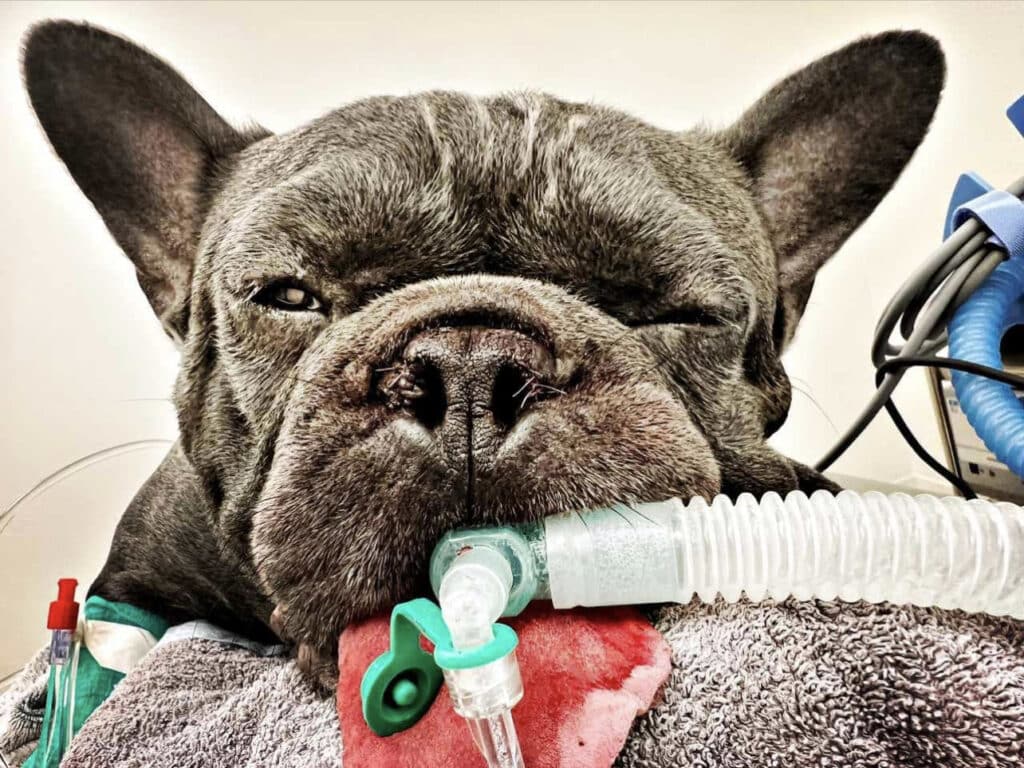
- Frequently asked questions and answers about brachycephaly
- What is Brachycephaly?
- How does brachycephaly occur?
- What problems does brachycephaly cause?
- Which Breeds Are Affected by Brachycephaly?
- How do you tell if a dog has breathing problems?
- Is snoring always a problem?
- Do breathing problems worsen as you age?
- Why do symptoms worsen at high temperatures?
- Can symptoms be relieved in summer?
- What are the consequences of non-treatment?
- What is multi-level surgery and which areas are operated on?
- Is the success of an operation permanent?
- At what age should you operate on a brachycephalic dog?
- Isn't surgery on older animals too big of a risk?
- How can I, as a pet owner, help my dog live as pain-free a life as possible despite brachycephaly?
- What does the Animal Protection Act say in this context?
What is Brachycephaly ?
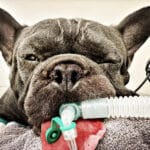
Dogs with short heads are described as brachycephalic ("brachis" = short and "cephalus" = head).
How does brachycephaly occur?

Brachycephaly, also known as short-headedness, is a skull anomaly that occurs in certain dog breeds such as Pugs, French Bulldogs and English Bulldogs.
This skull deformity is caused by a genetic predisposition that leads to abnormal shortening of the skull. Brachycephaly is the result of selective breeding, where breeders deliberately favor dogs with this skull structure in order to maintain the breed's distinctive appearance. The mechanism that leads to brachycephaly is the result of shortened prenatal development of the facial and cranial bones. The genetic factors that cause this abnormality affect the activity of growth factors and their receptors, resulting in reduced bone formation and development. As a result, affected dogs' skull bones are shortened and their faces appear flat and compressed.
What problems does brachycephaly cause?
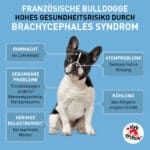
Despite the aesthetic appeal that many people find in brachycephalic dogs, brachycephaly brings with it a number of health problems. These include difficulty breathing due to a narrowed nasal cavity, restricted breathing and an increased susceptibility to heat stroke. In addition, dogs with brachycephaly may also have problems with their eyes and digestive system due to their abnormal skull structure. It is important to consider the health consequences of this skull deformity before deciding to acquire a dog with brachycephaly.
Which Breeds Are Affected by Brachycephaly ?
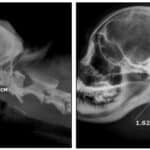
Brachycephaly primarily affects certain breeds of dogs known for their short, broad skulls and flat faces.
These characteristics are the result of selective breeding, where breeders deliberately favor animals with these characteristics. The breeds most commonly affected by brachycephaly include: - Pug : The Pug is a small breed of dog with a distinctive, flat face and large, round eyes.
This breed is known for its friendly and affectionate personality, but often suffers from health problems related to its skull structure. - French Bulldog : The French Bulldog has a compact build and a wide, flat face.
They are popular for their playful and adaptable nature, but also have an increased susceptibility to breathing and eye problems due to their skull anomaly. - English Bulldog : The English Bulldog is a medium-sized breed with a massive, broad head and a short, stocky body.
They are known for their gentle, loyal nature, but often suffer from a variety of health problems related to their brachycephalic skull structure. - Boston Terrier : The Boston Terrier is a small to medium-sized dog breed known for its distinctive "tuxedo" coat pattern and flat face.
Despite their lively and loving nature, they can also suffer from the health consequences of brachycephaly. - Boxer : The Boxer is a medium to large breed of dog with a muscular build and a broad, flat head.
Boxers are known for their energy and loyalty, but can have breathing problems and other health difficulties due to their brachycephalic features. - Pekingese : The Pekingese is a small breed of dog with a long, silky coat and a flat face.
Although they are known for their brave and independent nature, they are prone to respiratory and eye problems due to their skull structure. - Shih Tzu : The Shih Tzu is a small breed of dog with long, flowing fur and a short, broad face.
They are known for their friendly and affectionate personalities, but can also suffer from health problems related to brachycephaly. Some of the most famous brachycephalic cat breeds are:
- Persian cat : The Persian cat is one of the most famous and widespread brachycephalic cat breeds.
It is characterized by its long, silky fur, massive build and flat face. Persian cats are generally calm and affectionate. - Exotic Shorthair Cat : The Exotic Shorthair cat, also known as the "Exotic Shorthair", is essentially a Persian cat with short fur.
It has similar physical characteristics to the Persian cat, including the flat face and short bridge of the nose. The exotic shorthair cat is also a calm and loving breed. - British Shorthair (BKH) : Although the British Shorthair cat is not considered an extremely brachycephalic breed, it still exhibits some skull shortening.
The British Shorthair cat has a strong build, a round face and large, expressive eyes. She is known for her gentle and relaxed personality. - Selkirk Rex : The Selkirk Rex is another cat breed that exhibits brachycephalic features.
She is known for her curly coat and round face. The Selkirk Rex is friendly, playful and good-natured. It is important to note that not all individuals within a breed are affected equally, and the degree of brachycephaly can vary from animal to animal. However, the breeds mentioned above are more likely to suffer from the health problems associated with this skull anomaly.
How do you tell if a dog has breathing problems?
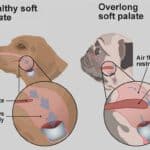
Breathing problems in dogs can be due to a variety of causes, including brachycephaly.
It is important to recognize signs of breathing difficulties in dogs early so that appropriate measures can be taken and possible complications can be prevented. The following signs and symptoms may indicate that a dog is having breathing problems: 1. Panting : Excessive panting can be a sign that a dog is having difficulty getting enough oxygen.
It's normal for dogs to pant in hot weather or after exercise, but if panting occurs for no apparent reason or lasts longer than usual, it could indicate breathing problems. 2. Changes in breathing : Changes in breathing rate, depth of breathing, or breathing noises may indicate difficulty breathing.
Examples include rapid, shallow breathing, wheezing or wheezing, or signs of shortness of breath such as stretching out the neck while breathing. 3. Nasal discharge : Nasal discharge or blocked nostrils can indicate an infection, allergies, or other problems affecting breathing.
In brachycephalic dogs, this can also be due to a narrowing of the nasal cavity. 4. Cough: Cough can be a symptom of breathing problems, especially if it is chronic or persistent.
It may indicate an infection, respiratory irritation, or an underlying condition such as heart disease. 5. Changed behavior or performance : Breathing problems can cause a dog to be less active or stamina-free than usual.
He may show less interest in games or walks, tire easily, or show signs of weakness or collapse. 6. Blue or pale mucous membranes : Decreased oxygen supply can cause the mucous membranes in the mouth, eyes, or genital area to appear blue or pale.
This may be a sign of severe respiratory distress or a medical emergency and requires immediate veterinary attention. 7. Sleep Disorders : Dogs with breathing problems may sleep restlessly or wake frequently because their breathing is affected while they sleep. In some cases, they may even sleep in an upright position to make breathing easier.
Is snoring always a problem?
Snoring in dogs is not always problematic, but in some cases it can indicate health problems.
Snoring occurs due to vibrations in the airway structures as air flows through them while breathing. In general, there are two main reasons why dogs snore: anatomical causes and health problems. Anatomical Causes : Dogs, particularly brachycephalic breeds, often have restricted airway passage due to their short noses and flat faces, which can promote snoring.
In these dogs, snoring is often normal and not necessarily a cause for concern as long as there are no additional breathing problems or symptoms. Health problems : In some cases, snoring can indicate health problems such as:
a. Obesity : Overweight dogs are more likely to have breathing problems and snoring because excess fatty tissue in the airways can restrict airflow.
b. Allergies or infections : Respiratory infections, allergies, or irritants can cause swelling or secretions in the airways that promote snoring.
c. Airway obstruction : Foreign bodies, polyps, tumors, or other growths in the airway can cause snoring and make breathing difficult.
d. Sleep apnea : In rare cases, snoring in dogs may indicate sleep apnea, where breathing temporarily stops during sleep.
This can lead to restless sleep and daytime sleepiness. If your dog's snoring occurs suddenly, worsens, or is accompanied by other symptoms such as shortness of breath, coughing, or changed behavior, it is advisable to consult a veterinarian to determine the cause of the snoring and possible health problems. In some cases, treatment or lifestyle adjustments may be necessary to reduce snoring and improve the dog's breathing and quality of life.
Do breathing problems worsen as you age?
Breathing problems in brachycephalic dogs can worsen or change throughout life, depending on various factors.
Some of the main reasons why breathing problems in brachycephalic dogs may increase over time are: 1. Aging Process : As with all dogs, brachycephalic dogs can experience natural aging processes over the course of their lives, affecting the muscles and elasticity of the airways.
This can cause the airways to function less efficiently and increase breathing problems. 2. Weight gain : Obesity is a common problem in dogs and can make breathing difficult, especially in brachycephalic breeds.
Excess fatty tissue can put pressure on the airways and cause breathing problems to worsen. 3. Inflammation and infection : Over time, repeated inflammation or infections of the respiratory tract can cause respiratory function to worsen.
For brachycephalic dogs who are already prone to breathing problems, this can lead to further deterioration in their ability to breathe. 4. Development of comorbidities : As brachycephalic dogs age, they may develop comorbidities such as heart problems or respiratory diseases, which can worsen breathing problems.
Why do symptoms worsen at high temperatures?
Brachycephalic dogs, due to their anatomical features, are more susceptible to respiratory problems and worsening of their symptoms in high temperatures.
The main reasons for this are: 1. Restricted airways : Brachycephalic dogs have restricted airways due to their short noses and flat faces.
This anomaly causes breathing problems even under normal conditions, but at high temperatures the situation worsens as the dog's body has to make extra efforts to cool down. 2. Inefficient panting : Dogs cool themselves primarily by panting, releasing evaporated moisture through their tongues and respiratory tract.
In brachycephalic dogs, this cooling mechanism is less efficient because their shortened airways restrict airflow and make it difficult to release heat. This can cause the dog's body temperature to rise more quickly and increase the risk of heat stress or heat stroke. 3. Respiratory tract swelling : High temperatures can cause increased swelling of the respiratory tract tissues in brachycephalic dogs.
This swelling can further narrow the airways and worsen breathing problems. 4. Increased oxygen demand : At high temperatures, the body's oxygen demand increases as the metabolic rate increases. Brachycephalic dogs already have a limited ability to absorb and release oxygen, so they reach their physiological limits more quickly in high temperatures.
Can symptoms be relieved in summer?
To relieve brachycephalic dog symptoms in high temperatures, dog owners should take a few precautions:
1. Cool environment : Make sure the dog has access to a cool, shaded environment to recover from the heat.
2. Fresh Water : Offer fresh, cool water at all times to ensure hydration and aid in cooling.
3. Limit activity : Avoid physical activity or walking during the hottest times of the day and choose cooler mornings or evenings for outdoor activities.
4. Recognize Heat Stroke : Learn the signs of heat stroke in dogs, such as excessive panting, increased heart rate, restlessness, vomiting, diarrhea, disorientation or collapse, and seek immediate veterinary care if suspected.
5. Cooling aids : Use special cooling products such as cooling vests, mats or bands to help your dog regulate his body temperature.
These products can help reduce stress on the respiratory system and keep the dog more comfortable. 6. Air-conditioned rooms : When possible, brachycephalic dogs should have access to air-conditioned rooms to help them cope with high temperatures.
This can be particularly important if ambient temperatures are extremely high or the dog is susceptible to heat stress. 7. Regular grooming : Proper grooming can help support heat regulation in dogs.
Make sure your dog's coat is brushed and trimmed regularly to remove dead hair and allow good air circulation. 8. Early detection of breathing problems : Watch for signs of breathing problems or shortness of breath in your dog, especially in high temperatures. If you notice that your dog is having difficulty, see a veterinarian immediately for appropriate treatment and recommendations to prevent and relieve breathing problems.
What are the consequences of non-treatment?
Failure to treat brachycephaly and its associated breathing problems can have a significant impact on the affected dog's health and quality of life.
Possible consequences of non-treatment can include: 1. Chronic shortness of breath : Untreated breathing problems can lead to chronic shortness of breath, which limits the dog's daily life and affects the ability to exercise, play, or interact with people and other dogs.
2. Increased risk of heat stroke : Because brachycephalic dogs have difficulty regulating their body temperature, they are at increased risk of heat stroke.
This condition can be life-threatening and in many cases requires immediate veterinary attention. 3. Sleep apnea : Breathing problems in brachycephalic dogs can lead to sleep apnea, a disorder in which breathing temporarily stops during sleep.
This can lead to restless sleep, restlessness at night and daytime tiredness. 4. Cardiovascular problems : The extra effort that breathing places on brachycephalic dogs can increase pressure on the cardiovascular system.
Over time, this can lead to heart disease and heart failure. 5. Respiratory inflammation and infection : Due to the restricted airway and increased effort required to breathe, brachycephalic dogs can be more susceptible to respiratory inflammation and infection, which in turn can further worsen breathing problems.
6. Decreased quality of life and life expectancy : Overall, not treating brachycephaly and breathing problems can significantly impact the affected dog's quality of life and life expectancy.
What is multi-level surgery and which areas are operated on?
In brachycephalic animals, breathing is often severely restricted in several narrow places at the same time. From front to back, these can be: nasal opening, nasal cavity, nasal exit, nasopharynx, larynx, larynx, trachea and bronchi. For example, if there are four bottlenecks and the operation only removes three bottlenecks, the best possible success cannot be achieved. Over ten years of experience with conventional surgical techniques and the knowledge of international experts such as Prof. Dick White have led us to carry out a "multi-level treatment" today, the aim of which is to expand all identified narrow areas at the same time. This is also known as “multi-level surgery.” However, we can only determine whether and where surgery is necessary after evaluating the imaging diagnostics and examining the respiratory organs.
Is the success of an operation permanent?
Shortening the soft palate alone usually does not lead to lasting success. This is the main reason we use more comprehensive and effective surgical treatments. It is also known in humans that when breathing with snoring, even extensive treatments require a certain "refresher" after a while. That's why, as part of the regular scope of treatment, we also offer a follow-up check after six to nine months with, if necessary, repeating the minimally invasive treatment (e.g. on the palate and base of the tongue).
There is also the possibility of easily removing any scarring (including using a CO2 laser).
In general, one must remember that with all treatment methods we are trying to correct the complex and serious consequences of incorrect breeding selection. We cannot completely eliminate all inherent defects with surgical measures. Our treatment goal cannot be noiseless and completely unimpaired breathing. We would like to enable animals that suffer from narrowing of the airways due to breeding to live a species-appropriate life with a significantly improved quality of life without permanent breathing obstruction or even shortness of breath.
At what age should you operate on a brachycephalic dog?
The optimal time for surgery on a brachycephalic dog depends on the severity of the breathing problems, the animal's general health, and the veterinarian's recommendation.
In general, surgery should be considered once the dog's breathing problems have been diagnosed and conservative treatment methods do not provide adequate relief. In many cases, surgery may be recommended for young dogs between 6 months and 2 years of age to reduce the risk of long-term complications and improve quality of life.
Early surgery has the advantage of minimizing airway damage that can result from chronic breathing problems and allowing the dog to lead a more active and healthy life. However, the timing of the operation should be tailored individually to the affected dog.
It is important to carefully weigh the risks and benefits of surgery and make the decision in close collaboration with an experienced veterinarian. The veterinarian will evaluate the dog's health, the severity of breathing problems, and the potential benefits of surgery and make an appropriate recommendation. For older dogs or those with comorbidities, the risks of surgery may potentially outweigh the potential benefits.
In such cases, it is important to consider alternative therapeutic approaches and to ensure careful monitoring and support of the dog in order to preserve his quality of life as much as possible. In summary, the optimal time for surgery on a brachycephalic dog depends on several factors, including the severity of the breathing problems, the dog's age and general health, and the veterinarian's recommendation. In many cases, early surgery can help reduce the risk of long-term complications and improve the dog's quality of life.
Isn't surgery on older animals too big of a risk?
Surgery can also be useful for older animals in order to improve the quality of life and reduce any existing secondary diseases.
The risk of surgery depends on various factors, such as the animal's general health and possible comorbidities. Of course, general anesthesia always carries an increased risk, especially in older animals, which is why we recommend appropriate surgical measures for younger animals. It is therefore important to have a thorough examination and diagnosis carried out by a veterinarian in order to make an informed decision about the need and risk of surgery.
In many cases, the operation is successful even in older animals and leads to a significant improvement in quality of life. Of course, general anesthesia always carries an increased risk, especially in older animals, which is why we recommend appropriate surgical measures for younger animals.
How can I, as a pet owner, help my dog live as pain-free a life as possible despite brachycephaly?
As a pet owner, there are several steps you can take to ensure that your brachycephalic dog lives as symptom-free and happy a life as possible despite his breathing problems:
1. Regular veterinary exams : Make sure your dog is checked regularly by a veterinarian to monitor his health monitor and identify potential problems early.
Follow your veterinarian's recommendations regarding diagnosis, treatment and prevention of breathing problems. 2. Weight management : Make sure your dog maintains a healthy body weight.
Obesity can worsen breathing problems in brachycephalic dogs. Offer a balanced diet and control the amount of food to avoid obesity. 3. Exercise and activity : Adjust your dog's activity level to his individual needs.
Avoid strenuous exercise, especially in warm weather. Instead, choose lighter activities and walks in the cooler mornings or evenings. 4. Stress reduction : Avoid situations that unnecessarily stress or excite your dog, as this can lead to breathing difficulties.
Create a quiet and safe environment and offer your dog plenty of opportunities to retreat. 5. Heat and cold protection : Protect your dog from extreme temperatures.
In summer, ensure there is enough shade and fresh water and avoid spending long periods outdoors in high heat. In winter you should protect your dog from cold and drafts, as these can also put a strain on the respiratory system. 6. Collar or Harness : Use a harness instead of a collar when walking to reduce pressure on the throat and airways and make breathing easier.
7. Recognize breathing problems : Look for signs of breathing problems, such as excessive panting, wheezing, or cyanosis (blue coloring of the tongue and gums).
If you notice such symptoms, consult a veterinarian immediately. 8. Collaborate with the Veterinarian : Consult with your veterinarian about possible medication or surgical treatment options to relieve breathing problems in your brachycephalic dog.
9. Education and training : Good education and appropriate training can help reduce your dog's stress levels.
Accustom your dog to new situations and environments gradually to avoid unnecessary fear or excitement. 10. Observing Sleep Behavior : Watch for signs of sleep apnea or snoring and, if necessary, seek veterinary care to discuss possible sleep disorders.
11. Environmental adjustments : Design the home environment to meet your brachycephalic dog's needs.
For example, avoid using stairs if your dog has difficulty navigating them, or make sure he lies on soft, comfortable sleeping areas to minimize breathing difficulties. 12. Socialization : Make sure your dog has plenty of opportunities to socialize with other dogs and people.
This promotes his well-being and helps reduce stress and anxiety. 13. Communicate with breeders and dog associations : Learn about responsible breeding practices and advocate for improving the health of brachycephalic dog breeds. This can help raise awareness of the problems associated with brachycephaly and, in the long term, improve the quality of life of affected dogs.
What does the Animal Protection Act say in this context?
In principle, the Animal Welfare Act prohibits precisely this type of breeding.
In §11b it says: "It is forbidden to breed vertebrates... if it is to be expected that during breeding,... body parts or organs for hereditary reasons are missing or unsuitable or reshaped for species-appropriate use, resulting in pain, suffering or damage appear." Brachycephaly has become a growing topic in veterinary medicine and animal welfare in recent years. Some experts are calling for stricter breeding standards and increased public education to reduce the prevalence of this skull deformity and associated health problems. Laws have already been passed in some countries to restrict or ban the breeding of dogs with extreme brachycephalic traits.
